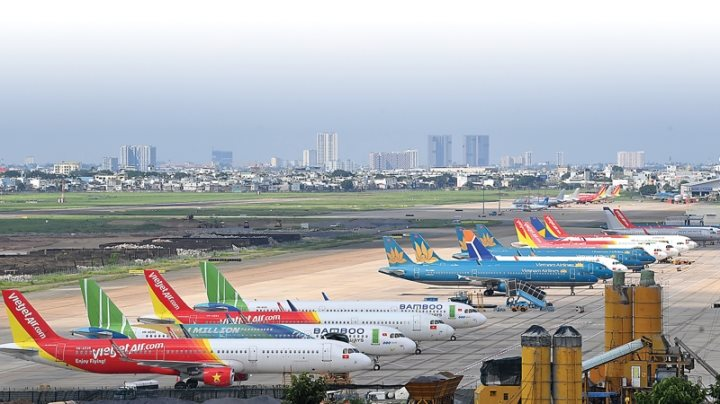Aviation sector taking off
The recovery of Vietnam’s aviation sector continues, led by improved performance in the international market, but pressing issues remain.

Its consolidated financial report for the first half of 2024 shows that the Airports Corporation of Vietnam (ACV), which manages and operates most airports around the country, posted net revenue of VND11.178 trillion ($442.2 million), an increase of 16 per cent compared to the same period of 2023. After-tax profit reached a record VND6.15 trillion ($243.5 million), up 45 per cent and fulfilling 81 per cent of the annual target. Its impressive gross profit margin of 63 per cent, meanwhile, reflects the company’s strong profitability.
Record profits for airports
ACV attributes its substantial growth in the first half primarily to the recovery of the international aviation market. Figures reveal that passenger traffic through ACV-managed airports stood at 54.7 million, achieving 48 per cent of the 2024 target but down 3.8 per cent year-on-year. International passengers totaled more than 20 million, up 38.5 per cent and nearing pre-Covid-19 levels. Domestic passengers reached 34.4 million, down 18.5 per cent due to fleet challenges that led Vietnamese airlines to reduce domestic flight capacity.
Analysts estimate that ACV’s revenue for 2024 as a whole will come in at VND23.9 trillion ($947.7 million), a 19.4 per cent increase compared to 2023, with pre-tax profit expected at VND14.5 trillion ($573.7 million), up 38 per cent, marking a historic high based on the assumption of a 14 per cent increase in passenger numbers this year.
However, the Corporation’s financial outlook is not entirely positive. As of the end of June, its bad debts had soared 45 per cent since the beginning of the year, to VND8.25 trillion ($326.6 million), and it had to allocate nearly VND3.9 trillion ($155 million) in provisions.
Recovery of airlines
Thanks to growth in the international market, Vietnam Airlines ferried nearly 11.5 million passengers and 143,000 tons of cargo in the first half of 2024, increases of 10 per cent and 42.1 per cent, respectively, compared to the same period of 2023.
Its financial report for the first half shows that the national flag carrier posted consolidated revenue of over VND53.126 trillion ($2.1 billion), up 20 per cent year-on-year. Post-tax consolidated profit was over VND5.476 trillion ($216.3 million), reversing the nearly VND1.4 trillion ($55.4 million) loss in the same period of 2023. Of this, core business profit was nearly VND1.143 trillion ($45.3 million), with additional profit of over VND4.531 trillion ($179.1 million), significantly boosted by debt forgiveness for Pacific Airlines.
The positive result comes despite challenges such as high fuel prices, unfavorable exchange rate fluctuations, low seasonal demand in the second quarter, and aircraft shortages due to a global recall of Pratt & Whitney engines. According to Vietnam Airlines, fuel prices remain high at an average of $102.14 a barrel, up 30.3 per cent against 2019, leading to additional costs of nearly VND2.5 trillion ($98.5 million).
Another crucial factor contributing to the carrier’s revenue growth was its focus on attracting high-revenue customers through service upgrades and enhanced digital transformation. Moreover, in its restructuring efforts, it successfully reached a debt forgiveness agreement of VND4.665 trillion ($184.8 million) with Pacific Airlines, significantly contributing to consolidated profits. The company’s proactive negotiation of payment deferrals, cost reductions, and flexible use of credit limits also helped ease cash flow pressure.
Meanwhile, Vietjet Air ferried 13.1 million passengers and operated 70,154 flights in the first half of 2024, surpassing 2019 levels and including over 5.5 million international passengers, a 52 per cent increase. In terms of consolidated business results, it posted over VND34 trillion ($1.35 billion) in revenue, up 15 per cent, and profit of VND1.117 trillion ($44.27 million), an eight-fold increase compared to the same period of 2023.
Its exceptional growth is largely attributed to the airline’s expansion of its medium-haul international network. With the continuous addition of new destinations, Vietjet now operates 111 international routes out of a total of 149, including prominent routes such as Ho Chi Minh City - Xi’an (China), Phu Quoc - Taichung (Taiwan, China), and Nha Trang - Daegu (South Korea).
Addressing challenges
In the latter half of 2024, despite the recovery in international markets, airlines will continue to face challenges such as high fuel costs, unfavorable exchange rates, rising aircraft rental fees, and reduced availability of aircraft domestically.
The severe aircraft shortage is significantly impacting revenue and profits for carriers like Vietnam Airlines and Vietjet. Vietnam’s fleet has shrunk from 230 to 167 aircraft, or nearly 30 per cent, due to global supply chain issues. This shortage has led to higher rental costs, increased maintenance expenses, and longer aircraft downtime.
To support carriers, the Civil Aviation Authority of Vietnam (CAAV) is to implement six solutions.
Firstly, enhance support for carriers to expand and optimize their fleets for better domestic services.
Secondly, negotiate with foreign aviation authorities to relax operational regulations and facilitate international operations.
Thirdly, monitor and assist Vietnamese carriers, focusing on Bamboo Airways and Pacific Airlines.
Fourthly, review policies on slot usage to ease restrictions caused by aircraft shortages.
Fifthly, ensure compliance with ticket sales regulations and protect passenger rights.
And sixthly, collaborate with the Vietnam National Authority of Tourism (VNAT) to boost tourism through comprehensive travel packages.







